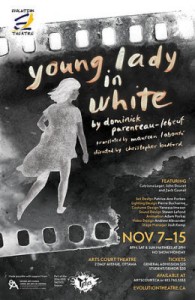Young Lady in White: A beautiful story in need of a purpose

Who are we? What is the purpose of our existence? These are questions many of us constantly ask ourselves. As such, they rank high above others on the priority list, whether they address pressing world issues, catastrophes of any proportion, or the very survival of anything that is not connected to us. That is exactly the story of the Young Lady in White. Photographed in the summer of 1932, and never developed due to the events that followed (the Nazis coming to power in 1933 and the
political changes they introduced), our protagonist is destined to live her life as a negative for 28,000 nights. The only company in her solitude and everlasting wait for her artist (who, she hopes, will come back to developed her) is the charming Chada – a cat that has never gotten further than sketch level. The negative girl and the sketch cat spend decades (from 1932 to 2009) in looking through the bathroom window at the world as it develops: atrocities during WWII, the total destruction brought on by the use of the atomic bomb, and victimized civilians in the post-war era. The girl doesn’t have much appreciation of the history that unfolds before eyes (except for the occasional ejaculation of surprise), but she listens to Chada, develops a strong companionship with him, and, at the end, destroys him for telling her an unwanted truth – that she is no more than an unknown negative, and that she will never be more than that. Finally, 10 years after the Berlin Wall fell, his prediction proved to be wrong: during the final clean-up of the area, a municipal engineer finds her in the darkroom and takes her with him. To be developed? Well, that is not the point of the story, which makes this ending of the play an artificial and rushed edition rather than a necessary ending statement.
Young Lady in White is a part of TACTICS – Theatre Artists’ Cooperative: the Independent Collective Series whose goal is to supports the growth of emerging theatre artists in Ottawa. If so, this play accomplishes the mission beautifully. Each segment of the play is commendable. Catriona Leger as a negative of the young lady is a true artist who successfully presents a character who is in limbo. Neither existent nor non-existent, a mere negative, undeveloped life emerges before our eyes and takes a form of an expectant girl. The atmosphere of “in-between” is clearly present, giving the whole play almost a ghostly feel. Leger owns the stage from the start to the finish. Her movements are light, her eyes speak volumes, and she is undeniably real in her unrealistic world. She portrays abstract ideas, expectations, and dreams just convincingly as more realistic feelings, such as jealousy, anger and disappointment. For an hour and forty five minutes, she carries the weight of a monologue (it is a one-woman show, although helped by few appearances of other characters) on the stage impeccably. A huge help in this area is Patrice-Ann Forbes’ intelligently designed set. The division of the stage into the back room, main room, as well as the stairs that lead to the bathroom and bedroom upstairs gives the actress a chance for more versatile movements, and thus adds to the desperately needed dynamic of the play. Well-chosen video projections of world events are presented in a timely fashion, and the movements of the beautifully animated Chada with his paws firmly rooted on the ground serves to keep the audience closer to the grim reality.
The play does lack a few point, the connection between elements being the biggest one. The negative girl looks as world history unfolds, but why? What is the connection between those events, the character, and the story? She obviously does not care much about them – she just seems to register them in passing. Is this out of curiosity, boredom, or something else? The videos also tend to lose their purpose. Instead of supporting the story, they are either easy to miss (while looking at Leger when speaks from upstairs, the audience members, naturally, miss the images downstairs) or distracting (looking at the videos causes missing the act upstairs). Two elements that should work together are, actually, conflicting.
Hand in hand with it is the length of the play. Even if you have someone as talented as Catriona Leger, it is still too long for a one artist show. By all means, bring innovation and challenge to the stage, but first of all, respect the medium.
The ending of the play is also damaging. It is very rushed and feels like it’s grasping for a happy ending at any cost. This disconnection, lack of dynamism, and amateurish conclusion makes the play look more like a very good acting workshop than a well-rounded play.
Young Lady in White plays at Arts Court Theatre until 15th of November 2014.
Young Lady in White
Production: Evolution Theatre
Written by: Dominick Parenteau-Lebeuf
Translated by: Maureen Labonté
Directed by: Christopher Bedford
Cast: Catriona Leger
John Doucet
Zach Counsil
Artistic Team:
Set Design: Patrice-Ann Forbes
Lighting Design: Pierre Ducharme
Costume Design: Vanessa Imeson
Sound Design: Steven Lafond
Animation: Adam Pockaj
Video Design: Andrew Alexander
Stage Manager: Josh Kemp